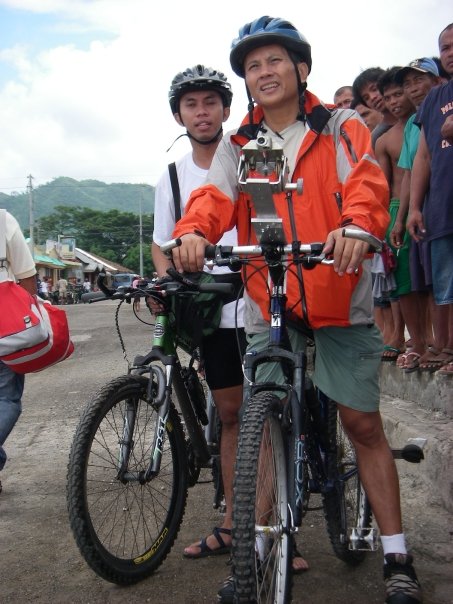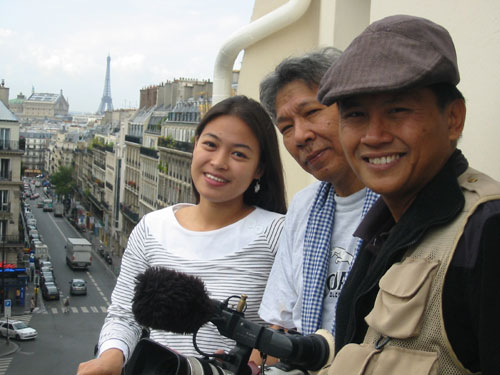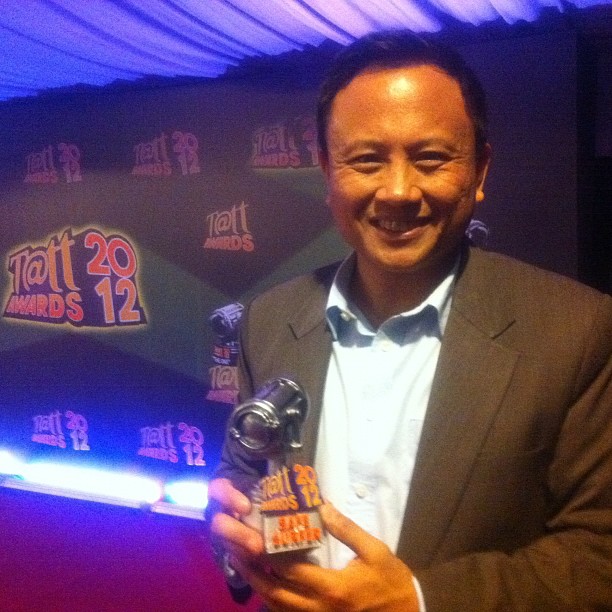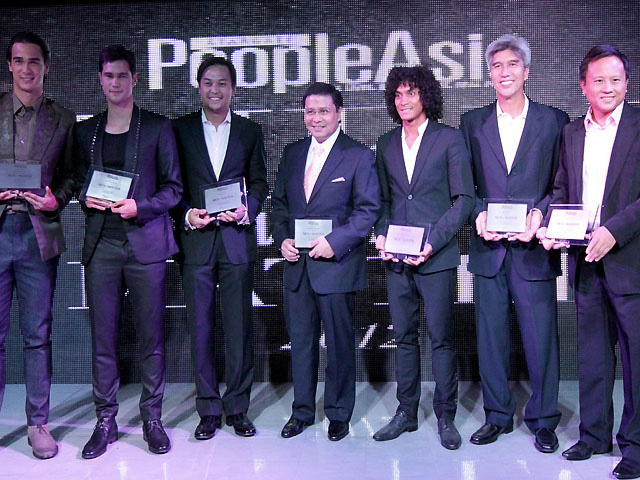As "I-Witness" marks its 13th anniversary this November, host Howie Severino is marking several milestones of his own. It’s been 10 years since Howie joined "I-Witness," and 15 years since he transitioned from print journalism to television. The year 2012 is also his third year as GMA’s vice-president for multimedia journalism and editor-in-chief of GMA News Online. From print to television to digital — his career path seems to have followed the evolution of media. But if you ask Howie, none of this was planned. In fact, he didn’t even appear on television for the first 10 years of his journalism career. “I loved watching TV journalism, but it hardly entered my mind that I would one day be doing it because I loved being a print journalist,” he says. “I just loved being a writer.” A late start

Howie Severino’s love for bicycles has made its way onscreen—several of his docus feature journeys on two wheels
Howie’s introduction to documentaries came in his late 20s, when he collaborated with a friend who was a documentary filmmaker. Howie would write the scripts, and his friend would shoot them. After appearing in a few independent documentaries that needed an on-screen narrator, Howie got the chance to join the pioneering magazine show “The Probe Team,” then airing on GMA-7, in 1997. “[I had the chance to] work with Cheche Lazaro, Luchi Cruz-Valdes, Nessa Valdellon, Robert Alejandro, Love Añover and many other really talented and great people,” he says. In contrast to news reports that were barely two minutes long, TV magazine programs allotted more airtime to each story. “When you’re given 20, 30 minutes, or even an hour, you can tell the story in depth, you can develop character, humanize people and tell the story of a place,” he says. Despite originally wanting to stay in print, Howie found himself drawn to this new, visual way of telling stories — one he describes as “warm,” because of how it stirs up emotions in viewers. He shares: “[One] thing I loved about doing documentaries, which you can say about all of cinema, is the emotional power that they pack.” “Especially for our culture and viewing public, the visual medium is just so much more powerful than other media,” he says.
A wider horizon 
The documentary team that produced "Little Bad Boy: Ang binatang Rizal sa Europa," (L-R) Executive Producer Ella Evangelista-Martelino, cameraman Egay Navarro, and Howie Severino, stand on the balcony of the Hotel de Paris, where Rizal first stayed in Paris.
As a child, Howie would tell people that he wanted to be a writer — to tell stories. With documentaries, he not only found a way for his stories to reach more people; making documentaries gave him an opportunity to embark on journeys of his own. He’s slept deep inside a cave in Samar, interviewed the Ampatuans in Maguindanao, seen gunfights in Basilan, and
ridden his bicycle across Bohol. He’s shot documentaries in Iraq, Japan, Kenya, and Belgium. In “Little Bad Boy: Ang Binatang Rizal sa Europa,” he retraced the steps of Jose Rizal in Brussels and Paris.

Howie Severino is active on Instagram. Here’s a photo of his taken while he was in Cebu, filming ‘Santo at Sikreto
At home, he has exposed the church’s failings during the month it welcomed a new Filipino saint. Last October, his "I-Witness" documentary “Santo at Sikreto” investigated the controversies surrounding the Filipino Catholic church, and how errant priests go unpunished. One of his most memorable stories was when he traveled to Iraq in 2003, right before the US attacked it.
“Ano ang kultura at pulitika nila bago baguhin ng giyera?” he asks. “It was a rare opportunity to show that because war changes everything about a country, society, and culture — sometimes forever.” We often think of stories and journeys in terms of what we see on our screens (i.e. 'They went there.'), but the process of making documentaries takes the filmmaker on an internal journey as well. For Howie,
whose first language was English, making documentaries bridged the gap between his “Filipino heart and soul” and the world of English-language books and websites he grew up with. He shares: “I’ve always found it ironic that I felt, before I entered the documentary field, that I could communicate best in English.” “Doing television and documentaries compelled me to try to become much better, not just at speaking Filipino, but also in writing and reading in Filipino,” says Howie. “There was a disconnect that doing documentaries has helped me bridge; in that way, documentaries have helped me become whole.”
The next journey 
June 2012: Howie Severino accepted the Safe Surfer Tatt Award for GMA’s campaign for responsible social media use, ‘Think Before You Click.’
After nearly 25 years of journalism, it’s been a long career for Howie Severino. What’s next? “To be honest, now that I’m older and I have a 10-year-old son that I love spending time with, I’m also quite happy staying at home,” he says, referring to his son Alon, who likes acting, skateboarding, cameras, and rapping along with Gloc-9. “I used to have a travel bug. I used to love being away, shooting on the road. But now, I’ve evolved into more of a homebody.”

Howie talks about electronic media at a forum for communications students.
While Howie jokes about retirement (“Can’t, I still need to pay tuition,” he laughs), he admits he wants to spend more time mentoring young journalists. “To me
kasi, part of everyone’s role, anyone who has specialized knowledge, is to share,” he says, predicting it will eventually become his main priority. But when he does embark on a new phase of life away from the cameras, he hopes audiences remember his stories. “[I hope] that I showed them aspects of the world that they would never have known about otherwise.
‘Yun lang,” he says. “To me, in my heart, that’s my primary identity. I just tell stories,” he adds. --
Fans from the I-Witness Facebook page also had a few questions for Howie Severino: Amiela Nicodemus: Is there any documentary you've made that changed your perception or views in your life? Howie: I did one recently where I walked around for a while without shoes to experience what many people experience every day of their lives. Now I know how hard it is. Even if you could say they’re used to it, I spoke with those people and it’s still difficult for them—especially for children. It’s still embarrassing for them. It still hurts them emotionally to be without shoes and to not be able to afford shoes. It was very eye-opening for me.
M Coronel Uy: Kung di kayo ngayon isang documentarist o nalilinya sa mass media, anong career ang gusto niyong tahakin, at bakit? Howie: I’d probably be some kind of journalist. But if I were not a journalist, maybe I’d be a teacher. But what would I teach? I’d teach... journalism? [Laughs]
Karl Angeles: Every time I watch an episode of I-Witness, I always end up wondering how much preparation it took to finish it. Can you give us a background on all the things that you do to come up with an interesting episode? Howie: Ang paggawa ng isang dokumentaryo ay isang napakagandang halimbawa ng teamwork. Datapwat iisang tao lang ‘yung mapapanood sa TV, sa totoo lang, ang kuwento ay produkto ng isang team na may kanya-kanyang tungkulin... Napakalalim ‘yung gratification at satisfaction tuwing nakatapos na kami ng isang dokumentaryo at alam kong pinaghirapan naming lahat.

People Asia Magazine's 'Men Who Matter 2012.' On the far right is Howie Severino.
Michael Jepthe Natad: Ano po ang payo ninyo sa taong gustong gumaya sa husay ninyo sa larangan ng pag-docu? Howie: Ang payo ko lang ay maging honest lang sa lahat ng ginagawa mo. Kasi the core of what we do is truth-seeking, and it’s hard to find the truth if you yourself are not truthful. When you start inventing facts and stories, and being dishonest with the audience, you’re betraying them and you’re betraying the profession... We need to strive for honesty in all aspects of our lives. The other thing is something more practical: Read a lot. In this kind of work, you need to write a lot and you need to write well. I haven’t met anyone who can write well who also does not read a lot. You can’t say “I’m gonna be a great writer” without committing yourself to being a great reader. As for finding the right stories, it takes a lot of research. A lot of it is trial and error. A lot of it is just loving this kind of work because it’s not easy. And develop your eye, because making documentaries is also a visual craft. Don’t be afraid to stare — stare at things that you find interesting... If you closely observe something, there’s a better chance that you’ll be able to understand it, and that you’ll develop an insight about it.

In “Bike-asyon sa Bohol,” Howie Severino met Peter Peligrino, a retired professor campaigning for a gubernatorial seat on a bike
Dante Dante: Hanggang saan natatapos ang ugnayan nyo sa mga tao o pangyayari na pini-feature nyo? Katulad ba kayo ng iba na pagkayaring kuhanan ng dokumentaryo ang isang kwento, iiwan na sila, pack-up na? Hanggang saan nanatili yung relasyon nyo sa kwento nyo? Howie: Iba-iba, case to case. May mga subject ako na hanggang ngayon, kaibigan ko pa rin. Kasama diyan yung lolo sa San Fransisco, yung beteranong sinundan ko ng anim na buwan. Talagang naging malapit kami sa isa’t isa. Hanggang ngayon, tinuturing ko siyang lolo. Kasi, wala na akong lolo. Isa pang halimbawa ang director na si Aureus Solito. Gumawa ako ng dokumentaryo sa kanya bago pa siya sumikat, tungkol sa paghahanap sa identity. Ako’y natutuwa na nakilala ko siya noong bata pa siya at ngayong sikat na director na siya, matalik na magkaibigan pa rin kami. May mga karakter naman na, syempre, pag-alis mo, lalo na kung malayong lugar, hindi mo na nakakausap muli. Pero yan ang isang dahilan kung bakit rin ako gumagawa ng dokumentaryo, dahil ito’y isang napakagandang paraan para makakilala ka ng iba’t ibang klaseng tao. Lahat ng mga karakter na sinamahan ko at ininterview ko at nakilala ko, nagiging bahagi na rin ng aking katauhan, ng aking karanasan sa buhay.
— PF/CM, GMA News To stay updated on the latest videos and web-exclusives from "I-Witness," like the program on Facebook (facebook.com/IWitnessGMA), follow them on Twitter (@IWitnessGMA) or visit their official webpage. Follow Howie Severino (@Howieseverino) on Twitter. 










